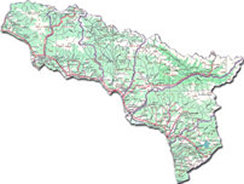Abkhazia
 The Abkhaz's
ancestors were part of the broad conglomerate of tribes that populated the
Eastern shores of the Black Sea more than 2000 years ago. Abkhazia covers
8.700 square km and had 525,061 inhabitants in 1989, 44 percent Georgian (Kartvehan),
17 percent Abkhazian, 16 percent Russian and 15 percent Armenian. Rural
population among the Abkhaz 52 percent (1989).
The Abkhaz's
ancestors were part of the broad conglomerate of tribes that populated the
Eastern shores of the Black Sea more than 2000 years ago. Abkhazia covers
8.700 square km and had 525,061 inhabitants in 1989, 44 percent Georgian (Kartvehan),
17 percent Abkhazian, 16 percent Russian and 15 percent Armenian. Rural
population among the Abkhaz 52 percent (1989).
According to Abkhazians, Abkhaz population are not less than 100.000, but they are a minority group in their own republic. The 1989 Soviet census gives the share of Abkhaz in Abkhazia as 17 percent. The largest group in the Republic were Georgians, and the rest primarily Russians and Armenians. As mentioned earlier the situation has not always been like that.
A Russian census from 1886 gives an Abkhaz figure of 59.000 constituting more than 85 percent of the population in Abkhazia.
In 1823 there were as many as 321.000 Abkhaz according to Abkhaz figures. Various sources agree that the population was at least halved after the final Russian colonisation of the North Chechnia in 1884 a fate similar to that of the related Circassians Further north. The group of Abkhaz emigrées consisted mostly of Muslims, which is the main reason why today's Abkhaz are more than 10 percent Christian. The exodus paved the way for an active Russian settlement policy that succeeded in increasing the number of Georgians and Russians in Abkhazia more than 50 times during 100 years. The above-mentioned demographic processes are closely related to the major issues and claims of the Abkhazians: the repatriation on their diaspora and the strengthening of Abkhaz language and culture after many years of Georgian and Russian influence and repression.
After Bolshevik revolution
Bolshevik power was established in 1918, to endure only 40 days when the Menshevik Georgia, protected by German and British forces, incorporated the area. The Abkhaz supported the Bolsheviks in their struggle for more independence. In 1921 Soviet power was re-established, and Abkhazia and Georgia signed a Union treaty. Abkhazia was recognised as a Soviet republic by the Bolshevik leaders of Georgia. In 1922, Abkhazia and Georgia entered the Transcaucasian federation as equal parts.
In 1931 however, Abkhazia was once again subordinated to Georgia as an autonomous republic. Abkhaz resistance to collectivisation was considerable, and an Abkhaz ASSR was established to please native and Russian Communist cadres in the area.
During the repressions in the late 1930s and early 1940s forced assimilation and Georgianisation of Abkhaz took place, led by Beria, head of the Transcaucasian federation at the time. Many Georgians settled in Abkhazia, Abkhaz language was no longer taught in schools, and many prominent Abkhaz were killed. After Stalin, there was again room to work for Abkhaz culture, also thanks to international attention because of the Abkhaz's supposed longevity. In the 1970s, a national movement was formed with the goal of seceding from Georgia and become part of the RSRSR. In 1978, Abkhaz intellectuals wrote an open letter to Brezhnev, expressing their concern for their ethnic population, and were met by certain economic concessions. An Abkhaz university was established in Sukhum.
Declaration of independence
In 1989 on the 9th of April (the Bloody Sunday), there were armed clashes between Abkhaz and Georgians. During the summer the conflict between Georgians and Abkhaz culminated, and in August 1990, Abkhazia declared its sovereignty and war broke out. The recent conflict in Abkhazia escalated after Shevardnadze came to power in 1992 and the Georgian parliament decided to reinstall the Georgian constitution of 1921, which does not mention Abkhaz. The Abkhaz parliament reacted to this humiliation by reinstalling their constitution from 1925 when Abkhazia was a Soviet republic.
Abkhaz invitations to talks were ignored by the political leadership in Tiflis until Georgia had the army occupy Sukhum and the southern part of Abkhazia in August 1992. However, the Abkhaz mobilized and were able to stop the Georgian advance with the aid of North Caucasian volunteers. After 13 months of war the Georgian troops were driven out of Abkhazia in September 1993. During the war the Abkhaz were supported not only by the North Caucasian minorities but by local Armenians and Russians. Also volunteers from the diaspora supported Abkhazia, mainly by providing financial support and lobbying for international understanding. It was Russia's role which has raised the most concern. Cossacks and volunteers from the Russian army took part in the fighting, and weapons and other materials were delivered from the backdoors of Russian army depots. Russian fighter planes were also spotted over Abkhazia. But whether Russia or maybe the Russian army acting on its own has taken an active part in the war has still to be confirmed. The UN became involved, and negotiations between Georgian and Abkhaz leaders began.
In June 1994 Russian peace keeping troops on behalf of CIS, and approved and observed by the UN, entered the border zone between the Georgian and the Abkhaz armies. It will be a major function of peace keeping arrangement to secure a safe return of the Georgian refugees. Most of the Georgians, who represented almost half of Abkhazia's population before the war, fled. Abkhazia has so far refused to let Georgians who participated in the fighting return.
Abkhazia, once a flourishing tourist resort, is today physically and economically exhausted. Many cultural items and symbols of Abkhaz history such as the National Archives have been destroyed. Many items of value, historical artefacts as well as computers and other modern technology, have reportedly been transferred to Tiflis.
Editor note: This information is from datebase of The Centre of Russian Studies (Norway) and The North Caucasus: Minorities at a Crossroads (Helen Krag and Larsh Funch). (FT)